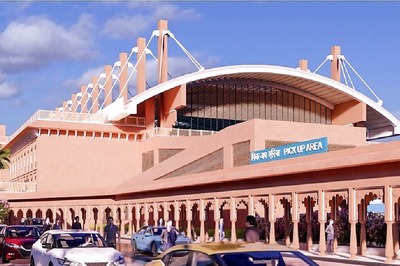
views
No obody expected any hungama this monsoon. So, the folks on the fourth floor of Mumbai's Maker Chambers IV, the headquarters of India's largest company, Reliance Industries (RIL), weren't prepared for the announcement when it came.
As the news flashed on television channels on June 11, employees went into a huddle wondering if it was true. A few got calls from curious friends and relatives. And the euphoria that emerged very soon could be described in only one way: Ab Kar Lo Duniya Mutthi Mein.
Mukesh Ambani had just announced that the Reliance Industries group was returning to the telecom business, less than a decade after it shook up the mobile telephony market with its CDMA-based service, a business that went to younger brother Anil Ambani in a fractious family settlement four years ago.
This time, Mukesh Ambani's bet is much more intriguing than his first one under Reliance Infocomm. He has bought unlisted firm Infotel Broadband, owned by the Nahatas, for a little over $1 billion. Infotel was the only firm to win a pan-India frequency on the broadband spectrum in an auction a few days before the deal. With this acquisition, Ambani has clearly indicated that he wants to usher in fourth-generation communication technologies (4G) to seed a data-rich services market, even as the entire telecom industry is grappling with the third-generation, or 3G, service roll-outs. Ambani or the handful of his lieutenants haven't spoken a word on what is in their mind, but the enormity of their plans has not been lost on the industry.
First of all, rivals are dumbstruck at the price that he has paid for Infotel to enter a risky and unproven market. "I would have lost my job if I had bid so high for the broadband wireless spectrum Reliance just bought. But my board is still confused if we have missed out on a big opportunity," says the CEO of a rival telecom infrastructure company, requesting not to be named. But the big question on everyone's mind is: Can Mukesh Ambani pull off his wireless broadband game plan and if he does, how will it change the face of the telecom industry? Ambani's last foray in telecom and the subsequent changes in technology and market trends throw up ample clues.
Make no mistake about it: Mukesh Ambani's plan will be predicated on a massive scale. In his first brush with mobile telephony in 2002, RIL's chairman and managing director launched a national rollout overnight and promised cheap mobile calls, creating a virtual frenzy in the market. His competitive plans pretty much helped the industry take off with big volumes, albeit into an era of falling user revenues. This time around, Ambani plans to offer to the masses all the ultra high-speed Internet and broadband services that were so far available only on wired or private networks. Reliance projects broadband subscriber number in India to reach 120 million in the next three to four years, growing to 10 times of what it is today.
Just as he then backed a technology (code division multiple access or CDMA) not chosen by the rest of the industry, Ambani is giving shape his latest plan with a technology choice that's an unknown quantity to many rivals.
Dialling In
Reliance's re-entry into telecom was a closely guarded secret known only to a chosen few. Manoj Modi, who spearheaded his telecom foray the last time around, was the most important. There were also a few bright, freshly minted management grads in the chairman's office who had worked on different aspects of the data business. Yet no one quite knew the full contours of the game plan. It now turns out that neither Ambani nor Modi had forgotten their ambitions in telecom and were just waiting for the right opportunity to strike. "Manojbhai (Modi) would often talk fondly of telecom but there was not a single clue we would do it again," says a senior RIL executive.
As the dates for the broadband auctions neared, Mukesh Ambani was still constrained by a non-compete clause he had signed with brother Anil. The two estranged brothers had returned to the negotiating table on another frustrating dispute: The sharing of natural gas produced by Reliance in the Krishna-Godavari basin with Anil's power projects. In his discussions, the elder brother managed to get the non-compete clause annulled just ahead of the auction date.
With that hurdle away, there will be a flurry of activity over the next three months. Even as this story goes to bed, Modi is drawing up a time-bound strategy to get services off the ground in the next 12 months. The plan is backed by an investment of $1 billion from the $6-billion cash reserves of Reliance. According to insiders, the company will spend the next two months forming alliances with tower infrastructure providers and begin work on tying up technology vendors.
The Devil Is in the Tech
The most intensely debated aspect of Ambani's plan is, of course, technology. At its investors meet, Reliance has clearly spelt out its preference for Time Division Duplex-Long-Term Evolution (TDD-LTE), a version of LTE wireless broadband technology that is awaiting commercial deployment.
But there is some lack of clarity. There are two popular broadband wireless technologies vying with each other for the favour of network companies, similar to the war between European GSM and American CDMA technologies for mobile telephony. WiMax has got backing from Intel, while Long Term Evolution (LTE) is being developed as the global standard for telecom companies using the ubiquitous GSM technology. Nearly 80 per cent of the global telecom industry has sided with LTE.
There is one hitch though: While WiMax is ready for deployment right away, it could take at least 12 months for Advanced LTE (4G) standards to be ratified by International Telecom Union (ITU). In the US, Verizon expects mobile LTE handsets on its network only in mid-2011. To that end, till more devices are available, Reliance will use 4G technologies only in its backhaul to create an high speed infrastructure.
Despite its public pronouncements to the contrary, Reliance is still actively considering WiMax, a senior Reliance executive says. "The focus will be to get to the market and capture the growth rather than wait around." But even if it opts for WiMaX initially, it is almost certain that Reliance will eventually migrate to LTE, as it is much faster than WiMax.
Either way, Ambani will be able to work around the bottlenecks that had prevented him from tapping the huge demand for high-speed data services in his first foray through Reliance Infocomm. That venture never lived up to the promise because of various reasons: Attractive CDMA handsets weren't available; high utility applications (think Apple's iPhone apps) did not materialise even though Reliance ran a 400-member software development team; and the optic fibre network could not withstand the assault from frequent breaking up of roads by civic authorities.
The wireless plan is devoid of any such irritants. Both WiMax and LTE have strong technology partners and a host of applications readily available to run on mobile devices (like Evo made by Taiwanese phone maker HTC). Users will start experience blazing speeds even in their existing wi-fi enabled devices to start with.
Citing data from Ericsson, Reliance has asserted that in 2009, mobile data usage surpassed that of voice globally. Last year, 400 million mobile data users consumed 140,000 terabytes of data per month, equivalent to the quantity consumed by 4.6 billion people talking on the phone.
As the base of data users grows, the average cost per MB of data will come down. This is exactly why Ambani slashed prices of mobile calls to 40 paisa per minute. Most experts expect him to unleash a similar war in the high-speed data services market. On the ground, there is enough evidence of a pent-up demand for broadband connections. For the last eighteen months, Nasdaq-listed Zylog has been expanding its wi-fi footprints across the country — in places like Chennai, Ludhiana, Tumkur and Mannargudi — with much success.
Tikona, a firm started by ex-Reliance Infocomm senior executive Prakash Bajpai, has expanded to 13 cities in less than a year and after winning broadband licenses in five circles in the current auction, hopes to triple rollout to 150 cities in the next 12 months.
With demand not a problem this time around, Reliance will focus on delivering high-speed services at a low cost to build scale. For this, it must keep a tight leash on costs. Its raw material — the broadband frequency on the electromagnetic spectrum — is the cheapest among competing technologies for mobile broadband. As compared to 3G, which will cost $ 0.32 per Mhz per person, broadband spectrum will cost only $ 0.06. Broadband penetration is less than 1 per cent in the country. So, Mukesh Ambani's bet to bypass voice services and focus on high-speed data delivery seems to be credible. However, revenues from broadband services is only a fraction of voice and therefore the trick lies in creating incredibly high volumes of data usage.
And it can get only better. The wave of technology adoption could force the government to retract its policy of not allowing voice calls on the Internet. Already, services like Skype are spreading like wildfire, though telecom companies can't offer a similar service legally. Once super broadband becomes common, the government may just allow Internet phone calls. When that happens, Mukesh Ambani's second tryst with telecom would come to a completely satisfactory conclusion.
His bet this time: An FAQ
How much are prices of high-speed Internet services likely to fall?
The benchmark price for visual entertainment today is the TV service which costs Rs 500 per family per month for a value-added package. Broadband Internet costs anywhere between Rs 750 and Rs 1,000 per month. Experts expect the prices for interactive high speed broadband to be around these levels.
Why does Reliance plan an asset-light business model by sharing existing infrastructure?
A nationwide tower infrastructure is available on hire from many companies like GTL. Companies like VSNK also offer a lot of optic fibre capacity that connects these towers. Reliance won't have to own infrastructure this time around. Even software development will be done with the help of vendors and not in-house.
Will Reliance have a free run in the broadband wireless space?
Not guaranteed. If customers continue to use the mobile phone as the main device, cell phone companies will be formidable competitors. LTE has its roots in GSM technology and companies like Airtel can easily use the existing infrastructure to roll out their networks quickly.
What kind of devices will drive Reliance's LTE play?
Expect a wave of new video enabled broadband devices to proliferate. Car cams, home security devices and iPad-like devices to beam educational programmes will become common. Mobile phones will have larger screens though battery technology is still in doubt.
Is there a technology risk in taking an early bet on Long Term Evolution (LTE)?
Reports from early implementation of LTE in Norway and Sweden by Teliasonera has been quite positive. As many as 110 operators in 48 countries have committed to rolling out LTE. Reliance was in the minority when it adopted the CDMA technology last time, but now the technology it has picked, promises to be a popular choice.
If devices to use high-speed broadband are still far away, why are companies scrambling to launch networks today?
The current Wi-Fi enabled phones and laptops are already capable of handling the speeds that the new networks promise. People will experience the technology through these machines and that would lead to emergence of more devices. What is missing, though, is the backhaul wireless bandwidth to cater to such a huge demand.



















Comments
0 comment